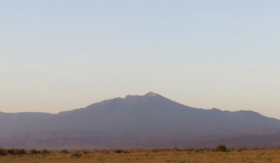Mousa Ali
| Mousa Ali | |
|---|---|
 Mousa Ali from Djibouti. | |
| Highest point | |
| Elevation | 2,021 m (6,631 ft) [1][2] |
| Prominence | 1,607 m (5,272 ft) [1][3] |
| Listing |
Country high point Ultra |
| Coordinates | 12°28′15″N 42°24′18″E / 12.47083°N 42.40500°ECoordinates: 12°28′15″N 42°24′18″E / 12.47083°N 42.40500°E [1] |
| Geography | |
 Mousa Ali Location of Mousa Ali in Djibouti (on tri-point border with Eritrea and Ethiopia) | |
| Location |
Tadjourah, Djibouti / Southern Red Sea, Eritrea / Afar, Ethiopia |
| Parent range | Denakil[3] |
| Geology | |
| Mountain type | Stratovolcano |
| Last eruption | Holocene |
The Mousa Ali Volcano is a 2,021 metres (6,631 ft) stratovolcano located on the tri-point borders of Ethiopia, Eritrea and Djibouti. The volcano is the highest point in Djibouti. The volcano's summit is truncated by a caldera, which contains rhyolitic lava domes and lava flows.[2] The last known eruption occurred before the Holocene era.
Mousa Ali is situated at the tri-point of the Tadjourah Region of Djibouti; the Southern Red Sea Region of Eritrea; and the Afar Region of Ethiopia.
Geography
The Mousa Ali is located in East Africa, in the north of the Great Rift Valley, which straddles the border triangle formed by the borders between Eritrea that covers its northern flank, Ethiopia that covers his flank south- west and Djibouti covering the Southeast flank. It is surrounded southeast by Djiboutian town of Dorra , southwest of the volcano Manda-Inakir and northwest by road from the Ethiopian town of Dessie in the Eritrean town of Assab.
History
Two strains of life in the area Afar. They are collectively known as Adrúmmi designated by 'Adó rum li "white as Byzantines ", which refers to its alleged particularly light skin.
The position of Ali Mousa as tripoint between Ethiopia, Eritrea and Djibouti is not the result of an agreement between the three countries. In December 1948 the British administering Eritrea refused to attend a meeting on site with the other two parties to determine the exact item. From 1952, he is no longer that of an internal border to Ethiopia. In 1954, Ethiopian delegates, however, refuse to demarcate the border of Eritrea.
This boundary becomes international in 1993 During the arbitration process, which sets the border between Eritrea and Ethiopia, Ethiopia boasts a tripoint further east, to Dadda'to. Finally, the Permanent Court of Arbitration sets the tripoint to Djibouti.
See also
References
- 1 2 3 Africa Ultra-Prominences, Peaklist.org, listed as "Moussa Ali Terara" Retrieved 29 September 2011
- 1 2 "Mousa Ali". Global Volcanism Program. Smithsonian Institution. Retrieved 2007-04-04.
- 1 2 "Moussa Ali" on Peakbagger Retrieved 29 September 2011